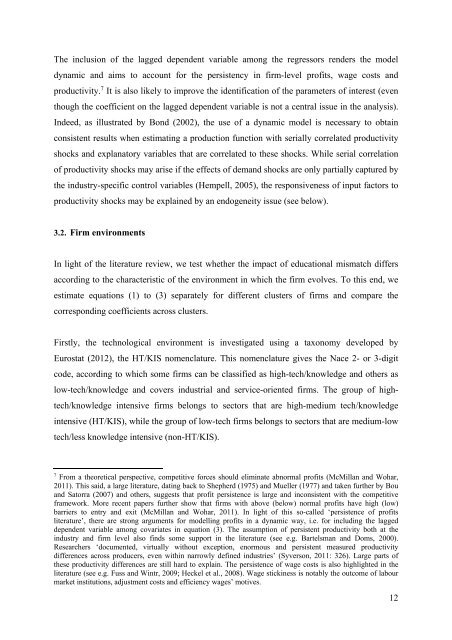CEB Working Paper
240798&r=lma
240798&r=lma
You also want an ePaper? Increase the reach of your titles
YUMPU automatically turns print PDFs into web optimized ePapers that Google loves.
The inclusion of the lagged dependent variable among the regressors renders the model<br />
dynamic and aims to account for the persistency in firm-level profits, wage costs and<br />
productivity. 7 It is also likely to improve the identification of the parameters of interest (even<br />
though the coefficient on the lagged dependent variable is not a central issue in the analysis).<br />
Indeed, as illustrated by Bond (2002), the use of a dynamic model is necessary to obtain<br />
consistent results when estimating a production function with serially correlated productivity<br />
shocks and explanatory variables that are correlated to these shocks. While serial correlation<br />
of productivity shocks may arise if the effects of demand shocks are only partially captured by<br />
the industry-specific control variables (Hempell, 2005), the responsiveness of input factors to<br />
productivity shocks may be explained by an endogeneity issue (see below).<br />
3.2. Firm environments<br />
In light of the literature review, we test whether the impact of educational mismatch differs<br />
according to the characteristic of the environment in which the firm evolves. To this end, we<br />
estimate equations (1) to (3) separately for different clusters of firms and compare the<br />
corresponding coefficients across clusters.<br />
Firstly, the technological environment is investigated using a taxonomy developed by<br />
Eurostat (2012), the HT/KIS nomenclature. This nomenclature gives the Nace 2- or 3-digit<br />
code, according to which some firms can be classified as high-tech/knowledge and others as<br />
low-tech/knowledge and covers industrial and service-oriented firms. The group of hightech/knowledge<br />
intensive firms belongs to sectors that are high-medium tech/knowledge<br />
intensive (HT/KIS), while the group of low-tech firms belongs to sectors that are medium-low<br />
tech/less knowledge intensive (non-HT/KIS).<br />
7<br />
From a theoretical perspective, competitive forces should eliminate abnormal profits (McMillan and Wohar,<br />
2011). This said, a large literature, dating back to Shepherd (1975) and Mueller (1977) and taken further by Bou<br />
and Satorra (2007) and others, suggests that profit persistence is large and inconsistent with the competitive<br />
framework. More recent papers further show that firms with above (below) normal profits have high (low)<br />
barriers to entry and exit (McMillan and Wohar, 2011). In light of this so-called ‘persistence of profits<br />
literature’, there are strong arguments for modelling profits in a dynamic way, i.e. for including the lagged<br />
dependent variable among covariates in equation (3). The assumption of persistent productivity both at the<br />
industry and firm level also finds some support in the literature (see e.g. Bartelsman and Doms, 2000).<br />
Researchers ‘documented, virtually without exception, enormous and persistent measured productivity<br />
differences across producers, even within narrowly defined industries’ (Syverson, 2011: 326). Large parts of<br />
these productivity differences are still hard to explain. The persistence of wage costs is also highlighted in the<br />
literature (see e.g. Fuss and Wintr, 2009; Heckel et al., 2008). Wage stickiness is notably the outcome of labour<br />
market institutions, adjustment costs and efficiency wages’ motives.<br />
12


